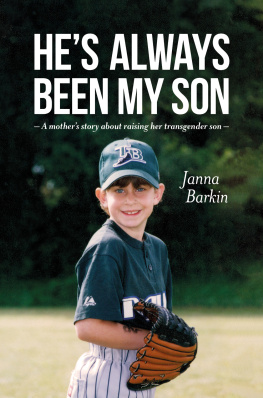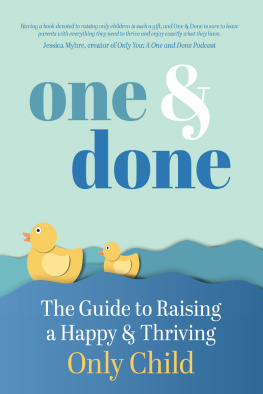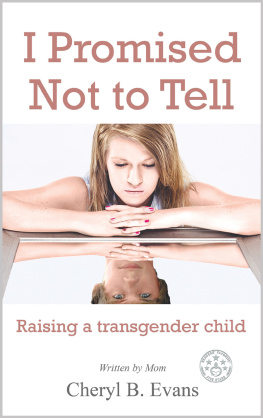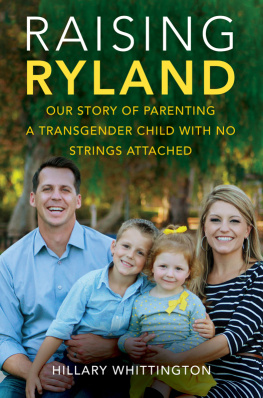
HES ALWAYS
BEEN MY SON
A mothers story about raising her transgender son
Janna Barkin

Jessica Kingsley Publishers
London and Philadelphia
CONTENTS
AMAYAS BLESSING
To the readers of this book
At the age of three, I began wearing boys clothes. By the time I was in the first grade my hair was cut short, never to be long again. In the seventh grade (when puberty was in full effect, not only for myself, but for my fellow classmates as well), I became increasingly aware of my developing chest. It wasnt until I was 14 and in the eighth grade that I started connecting the dots between these things.
At that point I decided to reach out to my parents. I sent an emailyes, an emailto my mother (the author of this book) expressing my discomfort. I knew her response would be positive and supportive, because thats the type of person she is. But still, it was extremely nerve-racking for me. Little did I know that sending that email would be one of the best decisions of my life.
It is hard for me to fathom that parents would be mad, disappointed, or have feelings of resentment when a transgender child expresses their authentic selves and entrusts their parents with that information. The sad truth, however, is that this happens all too often. Knowing this, I am even more grateful to have the support and unconditional love that I have from my parents. I could not be more proud of my mother for writing her story and sharing the knowledge she has gained in the hope of educating and supporting other parents as they undergo a similar journey.
So, with great excitement, I approve of the words my mother has written and I cannot wait to see the impact they have!
Sincerely,
Amaya Barkin
INTRODUCTION
There was not one ah-hah! moment when I knew my child was transgender. Early in the life of our youngest child, my husband, Gabriel, and I were keenly aware that Amaya was not your typical girl, or even your average tomboy. The signs were always there, from the way he insisted upon being dressed, to the so-called boy toys he consistently chose to play with, to the way he carried himself and moved his body. My understanding and acceptance developed over a long period of time and tracked closely with my childs understanding and acceptance of himself.
Before we go on, an important note about pronouns and gender-specific words:
To be clear, I will use male pronouns for Amaya consistently throughout this book, even though our family and community used female pronouns for Amaya until he asked us to switch at age 14.
Likewise, I will use the appropriate male, female, or gender-neutral pronouns for all other people in this book, with respect to each individuals gender identity.
Also, readers should note that I will use gender-neutral words ( they , them , and their ) instead of gender-specific words ( he/she , her/him , or her/his ) when I refer to singular people. For instance, I may refer to a child who expresses their gender variance.
When I first started looking for information and support to help me understand my child, I was lucky to find some valuable resources. At the time there were scant few voices and websites that provided information and perspectives about parenting a transgender child. I was unaware of the budding phenomenon called blogging, and todays abundant online blogosphere was in its infancy. Now there are many great resources available on the Internet and elsewhere. Sadly, the world is also full of a lot of misinformation, fear, hate, and ignorance.
My purpose in writing this book is to share and spread information, love, acceptance, and empathy. Every child deserves to be loved and supported unconditionally. Being transgender is just one more beautiful normal variation of being human.
Aside from my own deep connection to my trans-gender son, here are some other challenges faced by transgender people and their families that inspire me to write this book:
Lesbian, Gay, Bisexual, Transgender, Queer or Questioning ( LGBTQ) youth have among the highest suicide rates in the nation. While more studies are needed, currently it is believed that at least 25 percent of transgender youth have attempted suicide, and rates as high as 41 percent have been cited.
The Human Rights Campaign (HRC) conducted a groundbreaking study in 2012 in which 10,000 LGBTQ identified youth ages 1317 were surveyed. The results: 42 percent said that the community in which they live is not accepting of LGBT people; 26 percent said their biggest problems were not feeling accepted by their family/trouble at school/bullying, and fear to be out/open.
My husband and I are all so grateful to all of our extended family, to our wide circle of friends, and to all those within our greater community who have accepted and even embraced our sons transition. My family and I know we are fortunate in this regard, as many transgender youth do not experience this level of acceptance. I know we live in a bubble within a bubble within a bubble here in Northern California, as some might say, and I recognize our good fortune. There are many who dont have the support or resources that our family has, and I know part of my work is to advocate for those who are marginalized most.
It is my goal that the story I tell, as well as the memories and messages included in this book that were written by my close family and friends, provide consistently positive, uplifting, educational guidance to other families as well as to educators, counselors, transgender people, or anyone else interested in this issue. To support this goal, I have also included: resource information for legal and other assistance; notes on some of the latest research on gender; lists of non-profit and other organizations that support transgender youth and families; lists of medical and other health professionals skilled in working with trans youth; and information about online and local support groups for parents and their children.
I make this offering to parents, family members, and others who want to learn more about what it is like to parent , advocate for , and above all love a transgender child. It is my dear wish that sharing our story, we will open hearts and minds and help to bring about greater acceptance and equal treatment of all transgender and gender non-conforming/gender-expansive people.
I write to support, inspire, educate, and celebrate!
WHAT DOES THAT MEAN?
A GLOSSARY FOR THIS BOOK
The words we use to describe others and ourselves are important. Words we use to describe ourselves tell the world who we are and how we want to be seen. Words we use to describe others tell them what we think about who they are, based on what we have discerned from their own words and behavior as well as information from other inputs (peers, cultural norms, environmental factors, etc.).
Here are some words I use to describe myself:
I am a mom.
I am a teacher.
I am cisgender.
These are words I might use to describe my youngest child:
He is my son.
He is a student.
He is transgender.
Given that words are vital for understanding someones gender identity, it is important that I pause here to define some of the key terms used in this book. The terms below are significant and relevant to my familys story, and I will use these terms throughout these pages. For a more in-depth exploration of terms and definitions, there is a plethora of resources available online including the websites I used as primary references for the glossary included in this book, hosted by Gender Spectrum,
Next page






